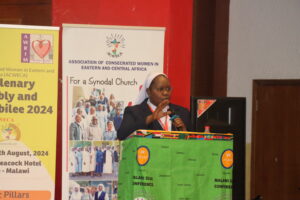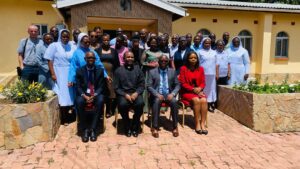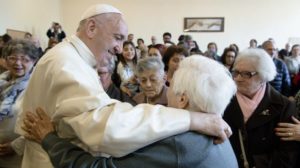AMECEA: AMECEA’S Homage to Popes John XXIII and John Paul II
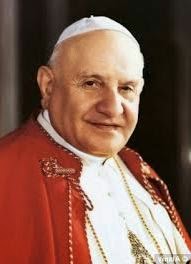
 |
| Pope John XXIII (Papa Buono) |
April, 2014, the universal Church will be celebrating the Canonization of the
Giant Popes of our time, John XXIII and John Paul II. The AMECEA family is joining
the rest of the world to pay homage to these garland Popes for their commitment
to the work of evangelization in the region and Africa at large. In other
words, the two Popes have seen the rapid growth of the Church in Africa from “Vatican
Council II to our entry into the Third Millennium”.
November, 1881, in Lombardy (Northern Italy). He was made Pope on 28th October
1958 and died in 1963. John XXIII had a remarkably simple and humorous
personality that earned him the name “Papa Buono” or Good Pope. What about us
as the AMECEA family, what can we saying about him? What legacy has he left for
the Church in our region?
appointed the first native Africa Cardinal, Laurent Cardinal Rugambwa, who was
born in Bukoba and was Archbishop of Dar-es-Salaam, in Tanzania. In this way
the Pope signaled the recognition of the growing importance of the Church in
Africa since by then it was a domain of European and American missionaries.
AMECEA region attended the Second Vatican Council which was opened by John
XXIII on 11th October 1962 and it closed by Pope Paul VI on 8th December 1965.
This provided for them the opportunity to hold their Second Plenary Assembly in
November 1964 at St. Anselm College in Rome. It was at this meeting that the
name of this regional body was changed from the Inter-Regional Episcopal Board
of Eastern Africa (ITEBEA) to the Association of Member Episcopal Conferences
of Eastern Africa (AMECEA). In addition, the Symposium of Episcopal Conferences
of Africa and Madagascar (SECAM), was also born during the Second Vatican
Council (1962-1965) in order to build the community of all the local Churches
in Africa.
Universal Church, John XXIII said, “as a Church we need to ‘open the windows’
to let the Spirit in.” This call for reform of the Universal Church helped the
Bishops of AMECEA to embark of renewal of liturgical celebrations into local
languages, enhance formation of the agents of evangelization and make ardent
commitment to integral human development.
Terris, On Establishing Universal Peace in Truth,
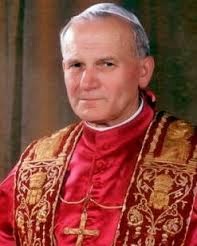 |
| Pope John Paul II (The Pilgrim Pope) |
Justice, Charity and Liberty
by John XXIII made remarkable contribution to promoting peace, quest for
national freedom and promotion of human dignity. During this time, many nations
in the AMECEA region, and Africa in general, were fighting for political independence
from colonial rule. In the third section of the encyclical, John XXIII appealed
for the need to recognize the equality amongst nations and the need for the
state to be subject to rights and duties that abide to the individuals
citizens. He said, “Peace on earth, which all men of every era have most
eagerly yearned for, can be firmly established only if the order laid down by
God be dutifully observed.”
an opportunity for the Church in the AMECEA to seek ecclesial renewal,
appreciation of the cultural values and a in a deeper understanding of building
the local Church that is self-propagating, self-ministering and self-supporting.
John Paul II at his Canonization for the legacy and memories he has left in shaping
the ecclesial structure, mission and pastoral activities of the Church in the
region. Pope John Paul II, Karol Jozef Wojtyla, was born May 18, 1920, in Krakow,
in southern Poland. On 16th October 1978, he was elected Pope and was Shepherd
of the Universal Church for 26 years until his death in 2nd April 2005. The
following year, the process of his canonization was announced.
made 16 visits to Africa, to 42 countries. He visited all the AMECEA countries
except Eritrea and Ethiopia. During his visits to Kenya (1980, 1985 and 1995) the
Pope opened Catholic Higher Institute of Eastern Africa (1985), which is now
known as the Catholic University of Eastern Africa (CUEA). CUEA has grown into
one of the most reputable universities in Eastern Africa that has continued to
provide quality education to agents of evangelization as well as the laity.
During the same visit (1985), the Pope celebrated with the AMECEA family the
International Eucharistic Congress that brought together the Christian faithful
from around the world.
and concluded the Synod of the Bishops of Africa with a Post-Synodal
Exhortation under the title Ecclesia in Africa. In this document, John Paul II
reflected on the model of the Church as Family and encouraged the Church in
Africa to be missionary to its own land and people. He also raised concerns for
the poverty, political unrest and other social issues affecting the people in
the region. In addition to these visits to Kenya, the Pope also visited Malawi
and Zambia (1989), Tanzania (1990), Uganda and Sudan (1993).
and continued to shape the missionary work of the Church in the AMECEA region.
He spoke, with appreciation, about the value of the Africa culture, the
youthfulness of the Church and zeal with which people are able to witness to
their faith. John Paul II showed special attachment to the young people. He
always provided a forum to interact with young people and encouraging them with
the message of hope in the message of the Gospel.
Popes, for their commitment to Shepherding the Universal Church with an
extra-ordinary love. They helped to significantly bring about renewal of the
Church in the region so that it becomes truly local, self-ministering,
self-propagating and self-reliant. Let us pray for their intersession that by
the example of their faith, hope and love, we may truly be a Church that is
truly the Family of God rooted in the teaching of the Gospel of Jesus Christ.
AMECEA Pastoral Department
